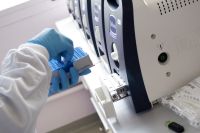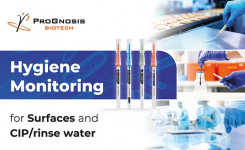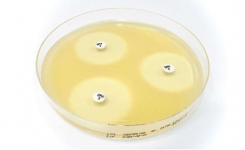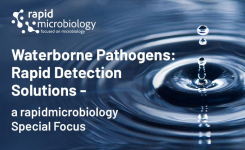 New Iam CMV provides speed and accuracy for the diagnosis and monitoring of CMV infection in immunocompromised patients.
New Iam CMV provides speed and accuracy for the diagnosis and monitoring of CMV infection in immunocompromised patients.
DiaSorin strengthens its infectious disease diagnostic portfolio with the launch of the Iam CMV assay for the molecular detection and quantification of cytomegalovirus.
DiaSorin has further expanded its range of infectious disease assays for use on the DiaSorin Liaison® Iam analyser with the launch of a new molecular assay for the rapid and reliable detection and quantification of cytomegalovirus (CMV). CMV is the most prevalent infectious pathogen in solid organ and bone marrow transplant recipients, and can lead to allograft rejection and other serious complications1-5. The DiaSorin Iam CMV assay is used to detect and quantify clinically relevant subtypes of CMV in human plasma, urine and cerebrospinal fluid (CSF), making it a valuable tool for the diagnosis and monitoring of CMV infection in transplant recipients and other immunocompromised individuals.
“DiaSorin offers a wide range of serology and molecular assays that play significant roles in the diagnosis and confirmation of infectious diseases,” said Paul Eros, Global Vice President Molecular, DiaSorin. “The potentially serious consequences of CMV infection in transplant and immunocompromised patients make Iam CMV an important addition to our infectious disease portfolio. The availability of real-time molecular diagnostic methods such as Iam CMV allows the rapid and sensitive diagnosis of active CMV infection. Furthermore, quantification of the viral load is invaluable for assessing the risk of CMV-related disease, to provide prognostic information, for guiding treatment decisions and for monitoring response to therapy2-6.”
Reactivation of latent CMV infection can occur in immunocompromised individuals7. With increasing numbers of transplant recipients, as well as expanding indications for immune-modulating agents, the number of people at risk of CMV disease and related complications is increasing5. The direct and indirect effects of CMV infection can have a significant impact on outcomes for transplant recipients2,4. Furthermore, CMV is a major cause of morbidity in AIDS patients and in others with impaired immunity, for example due to sarcoidosis, lymphoma and corticosteroid therapy6,7. Clinical manifestations amongst these patient groups include retinitis, pneumonitis, gastrointestinal disease and neurological disorders6,7.
Based on the innovative DiaSorin Q-LAMP technology, Iam CMV is the latest addition to an expanding portfolio of infectious disease assays for use on the DiaSorin Liaison® Iam analyser. It is a molecular assay for the detection of CMV in human amniotic fluid and for the detection and quantification of the virus in human plasma, urine and cerebrospinal fluid (CSF). Iam CMV has been standardised against the WHO CMV International Standard (NIBSC, UK)8,9, as recommended in the updated International Consensus Guidelines on the Management of Cytomegalovirus in Solid Organ Transplantation2. With excellent intra-run precision (≤ 0.3 log cps/mL) and with diagnostic sensitivity (≥97%) and specificity (100%) comparable to conventional PCR9, but with results in a fraction of the time required by PCR, Iam CMV provides a rapid and accurate method for the timely diagnosis and monitoring of CMV infection.
The small footprint, ease of use and scalable design of the benchtop Liaison® Iam Molecular Instrument makes it ideal for use in laboratory facilities of all sizes, including those that are located close to the patient. In addition to being used for the detection and monitoring of CMV infection in immunocompromised individuals, Iam CMV is also used in the diagnosis of maternal and foetal CMV infection in early pregnancy and for monitoring CMV infection in affected babies. The Iam CMV assay is CE marked in accordance to IVD Medical Device Directive 98/79 CE. This kit is available for use outside of the USA and Canada only.
For more information about Iam CMV, the Liaison® Iam instrument and the full DiaSorin molecular diagnostics infectious disease portfolio (including assays for Herpes Simplex Virus 1 and 2, Varicella zoster virus, Toxoplasma gondii, Parvovirus B19 and BK virus), email info@ie.diasorin.com or visit www.diasorin.com
References
1. Fisher, R.A. (2009) Cytomegalovirus infection and disease in the new era of immunosuppression following organ transplantation. Transplant Infectious Disease 11: 195-202.
2. Kotton, C.N. et al (2013) Updated International Consensus Guidelines on the Management of Cytomegalovirus in Solid Organ Transplantation. Transplantation 96:333-360.
3. Boeckh, M. (2011) Complications, diagnosis, management, and prevention of CMV infections: current and future. Hematology, Am Soc Hematol Educ Program.2011:305-9
4. Razonable, R.R. et al (2013) Clinical utility of viral load in management of cytomegalovirus infection after solid organ transplantation. Clin Microbiol Rev. 26(4) 703-727.
5. Kraft, C.S. et al (2012) Interpreting quantitative cytomegalovirus DNA testing: understanding the laboratory perspective. Clin Infect Dis 54(12):1793-1797.
6. Cheung, T.W. and Teich, S.A. (1999) Cytomegalovirus infection in patients with HIV infection. Mt Sinai J Med 66:113-124.
7. Department of Health, Victoria, Australia (Feb 2007) Infectious Diseases Epidemiology and Surveillance Bluebook. Cytomegalovirus infection.
8. Fryer et al (2010) Collaborative study to evaluate the proposed 1st [first] WHO international standard for human cytomegalovirus (HCMV) for nucleic acid amplification (NAT)-based assays. WHO/BS/10.2138
9. DiaSorin Iam CMV Instructions for use. CMV-525-02,EN 05/14.
10. Duff, P. (2010) Diagnosis and management of CMV infection in pregnancy. Perinatology 1:1-6.
11. Notomi et al (2000) Loop-mediated isothermal amplification of DNA. Nucleic Acids Research 28(12) Jun 15.
- 12. Fu et al (2011) Applications of loop-mediated isothermal DNA amplification. Applied Biochemistry and Biotechnology 163(7):845-50.
















